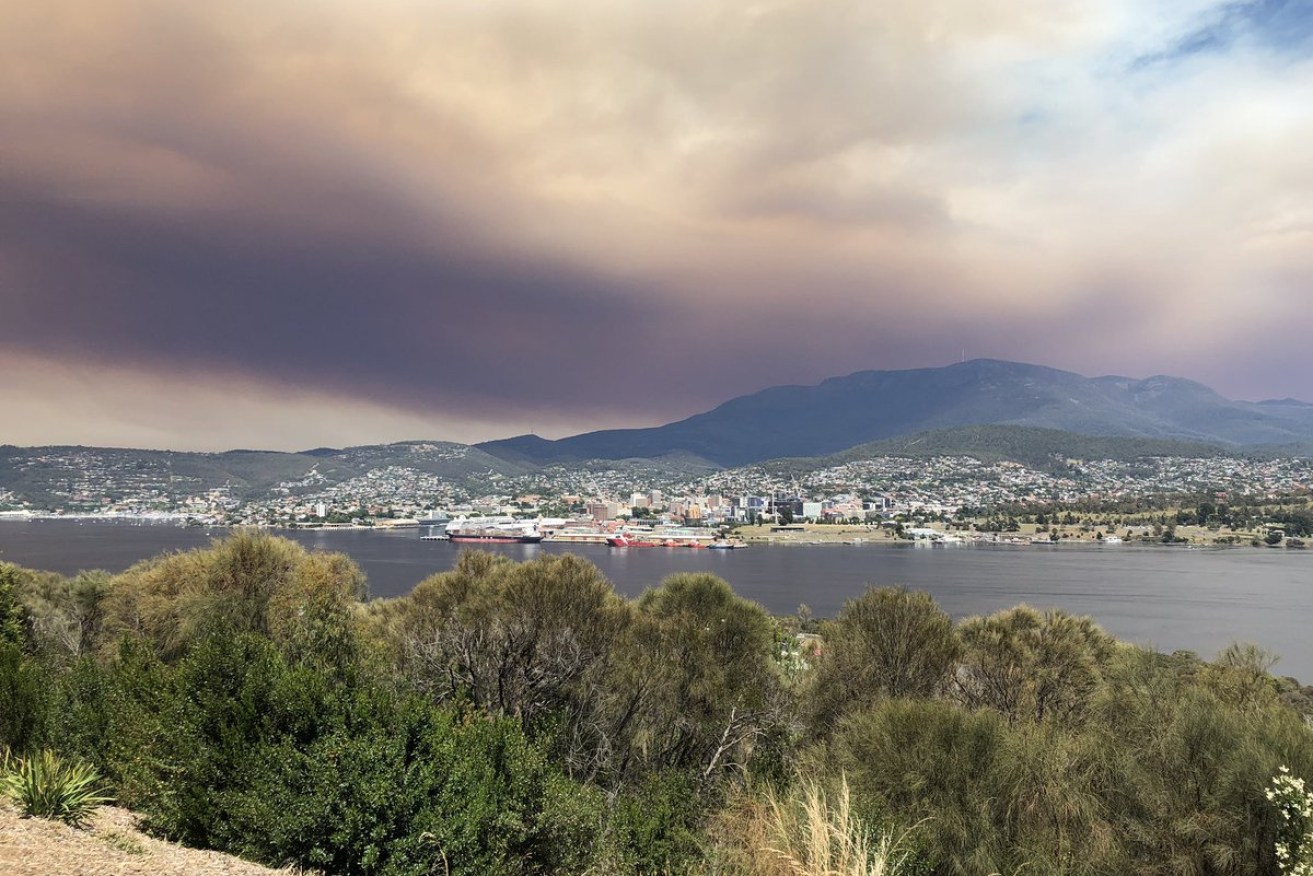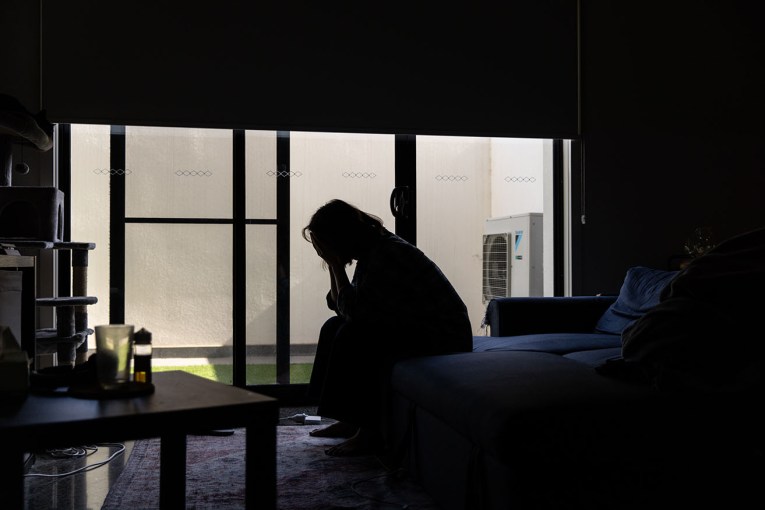Firefighters look to cool change for relief as blazes continue to ravage eastern Australia


Locals describe 'scary looking skies' over Hobart towards the state's southeast. Photo: Twitter
Firefighters will be looking to cold fronts for relief on Saturday as dozens of fires continue to burn across three states after a day of extreme temperatures in eastern Australia.
An out-of-control bushfire on Friday put southern Tasmanian communities at risk, with more than 15000 hectares of forest already burnt north of the small townships of Maydena, Tyenna and National Park.
On Saturday morning, fire services warned homes were no longer at immediate risk but residents were told to still brace for embers as the fire burns just 20 kilometres from communities.
Hobart is expected to reach a top of 22 degrees on Saturday after a high of 36 degrees on Friday.
NSW currently has 62 fires burning across the state, with 19 not yet contained. More than 100 firefighters were also called to a a fuel tanker explosion near Wollongong which blocked the M1 Motorway.
Intense skies over Royal Tasmania Yacht Club today due to bushfires southwest of #Hobart we hope everyone’s safe! pic.twitter.com/f5uyLscy4E
— clearairsailing (@clearairsailing) January 4, 2019
Stay safe Tassie #Hobart #SouthWest #Tasmania #bushfire pic.twitter.com/nUWenjbi1i
— Olivia Richardson (@richardsonliv_) January 4, 2019
A number of areas including the Greater Sydney Region, North Coast and Greater Hunter Region remain at high fire risk despite the mercury only reaching a top of 33 degrees on Saturday.
Melbourne is headed for a top of 21C on Saturday just a day after being belted with scorching heat while some northern centres hit 46C before a cool change swept through.
The milder conditions are expected to bring much relief for firefighters still battling a nearly 600-hectare blaze near Rosedale, in the state’s east, which has been burning overnight.
And passengers travelling overseas from Melbourne’s international airport are reporting flights have been cancelled due to extreme weather conditions. One family on its way to Canada on Friday afternoon reportedly had their flight cancelled until 8am on Saturday.
Residents and workers have taken to social media to show ‘scary looking skies’ looking back over the city towards the southeast.
Huge fires burning in #Tasmania
View from the roof at work, lunchtime today #Hobart #Bushfire #smoke pic.twitter.com/TMk8ostiLk— Blair Denholm (@blairdenholm) January 4, 2019
004/365
* not looking good from Hobart CBD – bushfire? •
.#Summer2019 #bellalunaboat #fireweather #australia #hot #hobart #tasmania #smoke #abcmyphoto #tasmaniagram #discovertasmania #wilderness1100 #seagypsies #fourbysea #abchobart https://t.co/KLkhDqfOJT pic.twitter.com/1cDhX875Yz— Beth-Mark-Zoe-Daisy (@bellalunaboat) January 4, 2019
Tasmania’s Parks and Wildlife Service’s Paul Black told reporters on Friday the fire was expected to subside overnight as the wind change and cold front moved in.
“Over the next couple of days we’ll have a much more moderate fire behaviour, which will give our crews an opportunity to make a very good assessment of what the fire has got to and what our control strategies should be from here on in,” he said.
In Victoria on Friday, at 3pm the Bureau of Meteorology recorded a high of 46 degrees at Waleup in the north of the state with Melbourne pushing 41.8 degrees before the cool change on Friday afternoon.
By 3.30pm, the bureau reported coastal towns from Warrnambool to Anglesea on the Bellarine Peninsular had dropped a massive 12 degrees, signalling the cool change was sweeping across Victoria’s west in what will be a welcome change.
Did you know you can track the #VicCoolChange on Doppler radar? It's visible as a faint line of blue moving up #PortPhillipBay. #Geelong dropped 12°C in 10min with the change. Still on track for 4pm at the #Melbourne observation site. Radar: https://t.co/1GVqUbMpIK #MelbWeather pic.twitter.com/ENhZY8gZds
— Bureau of Meteorology, Victoria (@BOM_Vic) January 4, 2019
Earlier, more than 100 NSW firefighters were called to the M1 Motorway near Wollongong when a fuel tanker carrying 36,000 litres of fuel exploded about 9am on Friday.
At least 20 emergency crews raced to the scene just after 9am on Friday to prevent the fire spreading to nearby bushland as temperatures rise across the state.
More than 100 firefighters were still dousing flames at 12pm and it is unclear as to when the motorway will reopen during the busy holiday period.
A 44-year-old man, the only occupant of the truck, escaped unharmed.
The intense blaze comes as Sydney’s west is forecast to reach the mid-30s while the mercury is tipped to hit 45C in other parts of the state on Friday.
#Wollongong #FuelTanker pic.twitter.com/glkKhIHzLX
— Dr Tamantha Stutchbury (@tamstutch) January 3, 2019
Elsewhere, total fire bans in place across Victoria and parts of Tasmania, with centres along the Victorian-New South Wales border are expected to be hit the worst, with Mildura, Kerang, Swan Hill and Echuca tipped to suffer through 46 degrees.
There is only milder relief further down south, with Melbourne predicted to reach its hottest day in three years with a top temperature of 42 degrees.
The extreme temperatures are thanks to hot, northerly winds blowing in from central Australia, the Bureau of Meteorology’s Dean Stewart told AAP.
Updated #VicCoolChange forecast. Right now #Walpeup is topping the leaderboard with a max temp of 44°C. #Melbourne has reached 38.1°C, while #Geelong has 41.5°C. Behind the change #Warrnambool is only 21.4°C and #Portland 18.9°C. Latest obs: https://t.co/tVwyriQ6A4 #VicWeather pic.twitter.com/J6zuRPlpvo
— Bureau of Meteorology, Victoria (@BOM_Vic) January 4, 2019
Mr Stewart said the temperatures of 46 and 44 for Bendigo in the state’s centre did not come around that often.
“The good news is it will only be relatively short-lived. That cold front will be coming across Victoria during the day,” he said.
From Friday afternoon, Melbourne can expect a sudden cool change and wind gusts of up to 100km/h.
Mr Stewart predicted the temperature could drop about 20 degrees as the front blows through.
The CFA on Thursday declared a total fire ban for the whole state for Friday.
Friday 4 January 2019 has been declared a day of TOTAL FIRE BAN for the whole State of Victoria. Plan ahead and understand what this means for you. Know what you can and can't do on a day of Total Fire Ban: https://t.co/Io6AlZ7Evh #vicfires pic.twitter.com/utTkH0rfwT
— VicEmergency (@vicemergency) January 2, 2019
High fire danger ratings are also in place across the state, with the Wimmera and Mallee regions listed by the CFA as ‘extreme’ on the fire ratings range.
Severe ratings are active for the South West, Northern Country, North Central and Central district, and a very high rating is in place for the Gippsland and North East regions.
During total fire bans, no fires can be lit in the open air.
A total fire ban is also in place for most of Tasmania, as the island state prepares for hot temperatures and strong winds.
The state maximum is expected to peak at 39 degrees, a temperature rarely seen in the state.
The mercury is likely to peak around 3pm before an afternoon cool change brings relief to Hobart and sweeps up the east coast.
Friday marks the sixth anniversary of Tasmania’s Dunalley bushfires that destroyed hundreds of homes in the state’s southeast.
A total fire ban is in place for the eastern half of the state.
Popular national park tracks at Mt Field, Freycinet and Maria Island have been closed due to the extreme heat.
-with AAP








